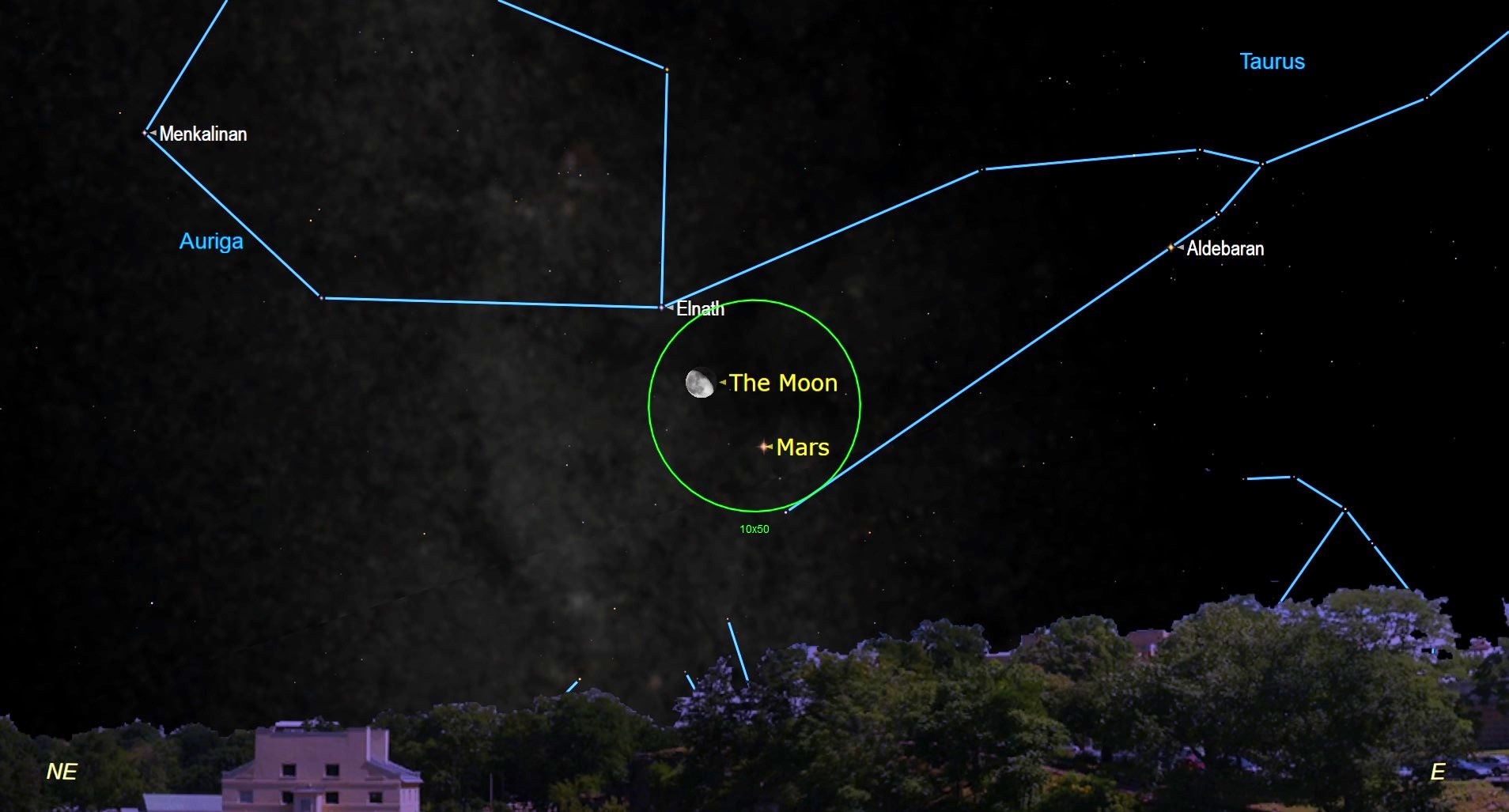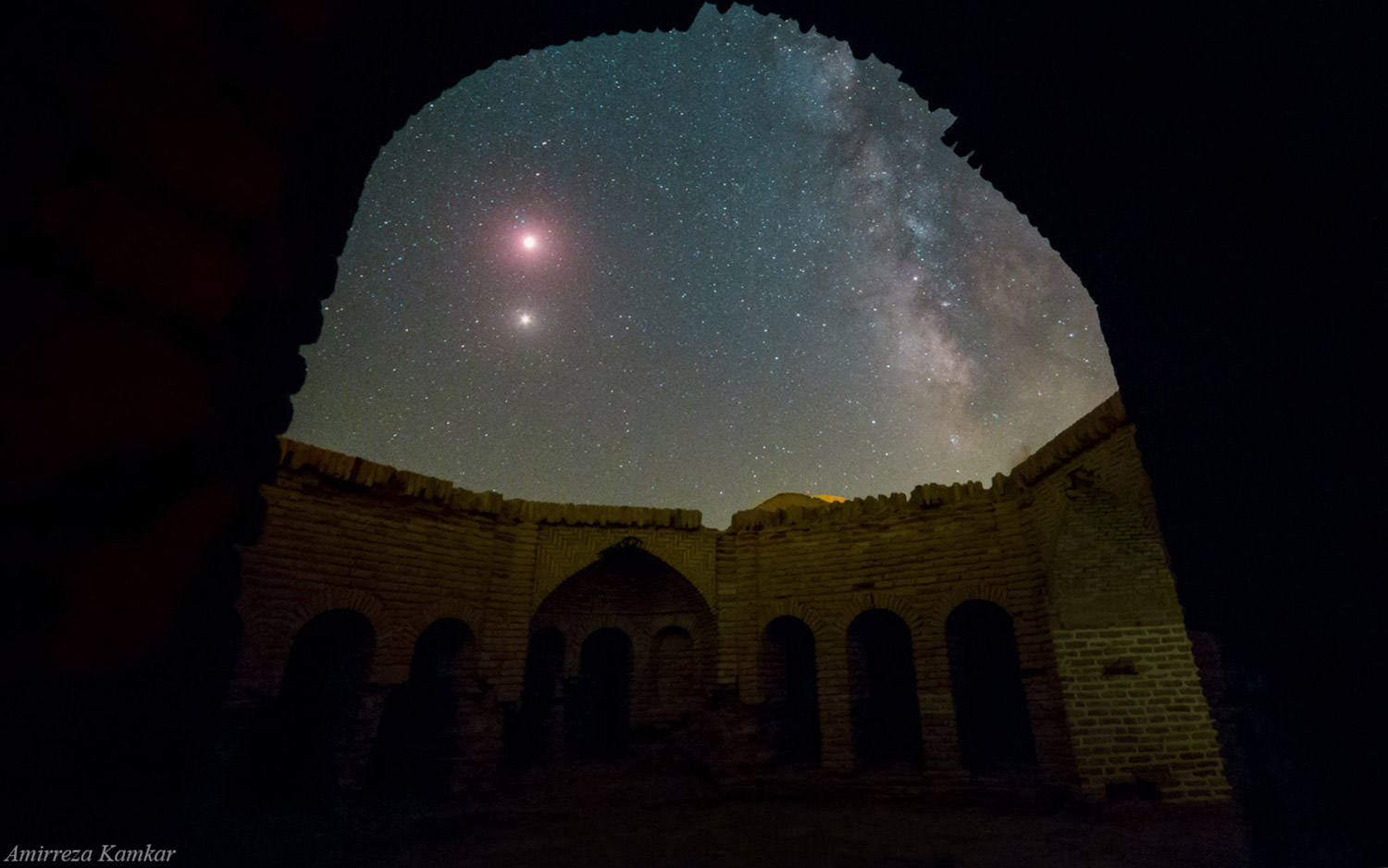
During the late evening hours of Friday (Oct. 14), those who are outside will no doubt take note of a waning gibbous moon, 74 percent illuminated and just 2 and a half days from its half or last quarter phase.
But there will also be another object, appearing to hover to the lower right of the moon; glowing like an orange luminary in the dark of the night. That object is not a star, but one of our planetary neighbors: Mars. Its proximity to the moon will no doubt have not a few folks asking the question, "Just what is that fiery-colored thing that's glowing below the moon?"
In fact, I wouldn’t be surprised if a few people dial their local police stations to report a UFO.
Related: Total lunar eclipse: How to prepare for next month's eclipse of the moon
In a little under eight weeks, Mars will be at opposition to the sun, when it will be in the sky all night; rising at sunset, reaching its highest point in the south in the middle of the night and setting at sunrise. Now, however, Mars does not rise until just after 9 p.m. local daylight times and won't reach its highest point until 5 a.m.
Oppositions of Mars occur on an average of about every 2.2 years. But not all Martian oppositions are alike. Indeed, the oppositions later in this decade will lean ones for observers of Mars. Those who witnessed its spectacular approach to within 35.78 million miles (57.58 million km) of Earth in July 2018 will have to settle for increasingly poorer views of the red planet as the Earth-Mars orbital geometry became more unfavorable in the coming years ahead.
Read more: Amazing Photos: The 'Blood Moon' Eclipse and Mars Opposition of July 27, 2018
Get the Space.com Newsletter
Breaking space news, the latest updates on rocket launches, skywatching events and more!

In stark contrast to 2018, Mars will come no closer to Earth than 59.7 million miles (96.1 million km) in 2025, 63.0 million miles (101.4 million km) in 2027 and 60.2 million miles (96.8 million km) in 2029.
But before this stretch of lean years arrives, we have one more "decent" Mars. Later this fall, on Nov. 30 at 9:17 p.m. EDT (0117 GMT on Dec. 1) , Mars will make its closest approach to Earth until May 11, 2031 coming to within 50.61 million miles (81.43 million km).
On Friday (Oct. 14) at 9:45 p.m. EDT (0145 GMT on Oct. 15), the moon will pass closest – 2.9 degrees – to the upper left of Mars. As the night wears on, the moon and Mars will slowly get progressively farther apart. By 5 a.m., Mars and the moon will be literally soaring high in the southern sky, but they will now be more than 4 degrees apart. (To gauge degrees in the sky, extend your arm and make a fist; your fist's width equals about ten degrees).

Looking for a telescope to see Mars or get an up-close look at the moon? We recommend the Celestron Astro Fi 102as the top pick in our best beginner's telescope guide.
Mars currently shines at magnitude -0.9, making it brighter than any star in the sky save for Sirius the Dog Star, the brightest star in the sky. (The lower an object's magnitude, the brighter it appears to the eye.) But as Mars draws progressively closer to Earth – about 316,000 miles (509,000 km) each day, its brightness will increase markedly. By Nov. 10, it will surpass Sirius in brilliance and when it arrives at opposition on the night of Dec. 7, it will attain a peak magnitude of -1.9.
That's more than twice as bright than it appears now!
Something for you to think about when you watch its rendezvous with the moon on Friday evening.
Joe Rao serves as an instructor and guest lecturer at New York's Hayden Planetarium. He writes about astronomy for Natural History magazine, the Farmers' Almanac and other publications. Follow us on Twitter @Spacedotcom and on Facebook.
Join our Space Forums to keep talking space on the latest missions, night sky and more! And if you have a news tip, correction or comment, let us know at: community@space.com.

Joe Rao is Space.com's skywatching columnist, as well as a veteran meteorologist and eclipse chaser who also serves as an instructor and guest lecturer at New York's Hayden Planetarium. He writes about astronomy for Natural History magazine, Sky & Telescope and other publications. Joe is an 8-time Emmy-nominated meteorologist who served the Putnam Valley region of New York for over 21 years. You can find him on Twitter and YouTube tracking lunar and solar eclipses, meteor showers and more. To find out Joe's latest project, visit him on Twitter.









